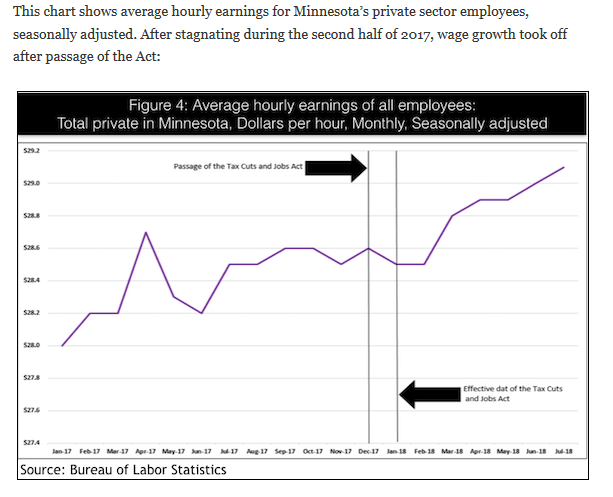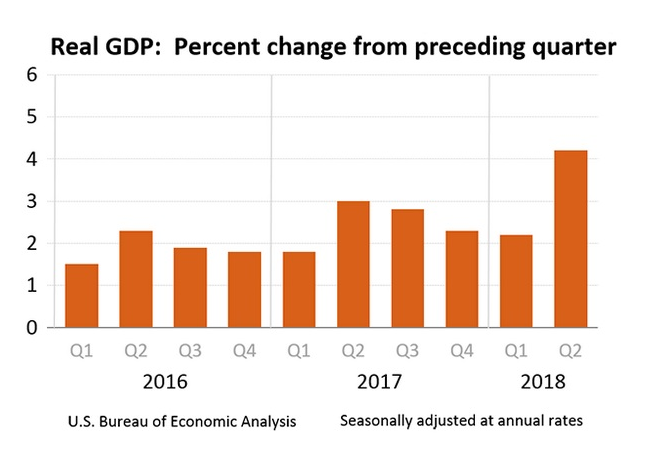During the final weeks of the mid-term election campaign, you will hear Democrats say, “The tax cuts were only for the rich–they didn’t help anyone else.” A misinformed friend of mine posted that on Facebook recently. So let’s look at the facts.
The Conservative Treehouse posted an article yesterday about the impact of the Trump Tax Cuts on average Americans.
The article quotes a Business Insider article that reports the following:
- Walgreens Boots Alliance announced that it will make investments around $150 million to boost mainly its in-store wages in fiscal 2019 in the light of favorable tax reforms.
- Walgreens CFO said Thursday that the increase in store wages was “in light of the favorable tax reforms in the US.”
…The pharmacy-chain owner Walgreens Boots Alliance announced Thursday that it will make investments of about $150 million to boost mainly its in-store wages in fiscal 2019 in wake of President Donald Trump’s tax reforms.
The announcement marks a 50% increase in company’s investment towards wages which was announced in March. At the time, Walgreens said it would invest around $100 million per annum to increase wages beginning later this calendar year.
“We will be making select incremental investments of around $150 million in fiscal 2019, mainly in store wages, but also to fuel our new community health care initiatives, and you can view these in light of the favorable tax reforms in the US,” Walgreens CFO James Kehoe said Thursday, on the company’s fourth-quarter earnings call.
The article at Business Insider explains how the tax cuts have impacted the average worker:
In December 2017, the Trump administration slashed the federal corporate tax rate from 35% to 21% and allowed a one-time repatriation of overseas cash. The bill also allows companies to bring overseas profits back home to invest in domestic projects or repurchase of shares.
Kehoe said the investments will result in a headwind of approximately $0.12 a share, or two percentage points of earnings-per-share growth for the coming fiscal year.
US retailers are scrambling to keep workers as they look for opportunities with higher pay and attractive benefits. The US unemployment rate fell to a 48-year low of 3.7% in September. According to the Bureau of Labour statistics, there were 757,000 retail-job openings across the United States in July, which is about 100,000 more than a year ago.
The surge in the number of retail jobs has allowed workers the opportunity to move around within the industry. As a result, companies are raising wages to try and retain workers. Earlier this month, Amazon hiked its minimum wage to $15 per hour, effective November 1. That followed wage hikes from places like Target and Costco.
That is significant.
The Conservative Treehouse concludes:
Back in January 2017 Deutsche Bank began thinking about it, applying new models, trying to conceptualize and quantify MAGAnomics, and trying to walk out the potential ramifications. They began talking about Trump doubling the U.S. GDP growth rate when all U.S. investment groups couldn’t yet fathom the possibility.
It’s like waking up on Christmas morning every day to see the pontificating Fed struggling to quantify analysis of their surrounding reality based on flawed assumptions. They simply have no understanding of what happens within the new dimension.
Monetary policy, Fed control over the economy, is disconnected and will stay that way for approximately another 12-14 months, until Main Street regains full operational strength –and– economic parity is achieved.
As we have continued to share, CTH believes the paycheck-to-paycheck working middle-class are going to see a considerable rise in wages and standard of living. How high can wages rise?… that depends on the pressure; and right now the pressure is massive. I’m not going to dismiss the possibility we could see double digit increases in year-over-year wage growth in multiple economic sectors in several regions of the U.S.
Remember, as wages and benefits increase – millions of people are coming back into the labor market to take advantage of the income opportunities. The statistics on the invisible workforce varies, but there are millions of people taking on new jobs in this economy and the participation rate is growing.
Winnamins. We’ll need lots of them…
Wow.



